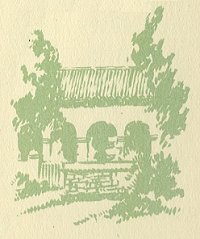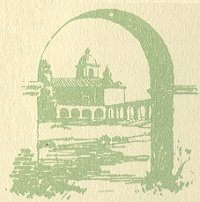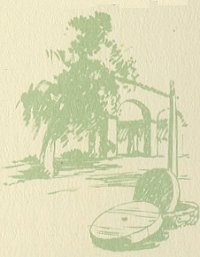
 |
When the Franciscan Mission Fathers arrived at San Diego in the year 1769 our California of today stretched before them a thousand miles of desert. It was a beautiful desert, but for the purposes of civilized man it was the desolation of a wilderness.
This wonderful body of trained Franciscan missionaries who came from Spain up through the mysterious Mexican Peninsula to the bright shores of the Bay of San Diego wrought upon the desert with magical hands. They took an idle race and put it to work--a useless race that
 |
It was around the old Missions that the colorful social life of the early Spanish inhabitants centered. Song and laughter filled the sunny mornings. There was feasting and music, the strum of guitars and the click of castanets under the low hanging moons. Toil was easy and the burden of existence light. It was a sheer Utopia. Nothing like it ever existed before, nor has any approach to it existed since.
And yet the dream was not without difficulties for those who wrought it. It was no small achievement to make a desert blossom as the rose and to make so many blades of grass grow where none grew before. To look back upon it now is like looking upon a beautiful play upon a stage harmonized to the ear and eye and which those who see and hear accept so happily but without a thought of the patient effort that was behind it all.
When one looks back upon the achievement of the establishment of the Franciscan Missions in California it is almost unbelievable that so many difficulties were overcome and so many obstacles conquered.
The first great difficulty that presented itself to the Padres was that in the different localities between San Diego and San Francisco the Indian tribes spoke different tongues. It was necessary then to establish a common language so that the natives of one place could converse and have intercourse
 |
 |
I think perhaps the least difficult task was the conversion of the Indians to Christianity. They really had no religion of their own as other savage peoples have had, and it appears that they willingly and even eagerly accepted the glamorous creed of Christianity. Anyhow, it is a fact that the whole race in California was Christianized. And the remnant of the race that still exists will be found by whoever goes among them to be very staunch Christians.
The miracle of inducing the California Indians to work was fully achieved. The proof of it is the chain of twenty-one Mission establishments which were erected and fashioned in beautiful architecture, and which now, alas, lie in ruins between San Diego's Harbor of the Sun and the peaceful and beautiful Sonoma in the Valley of the Seven Moons.
The Mission Fathers while being primarily missionaries burning with zeal for the conversion of the heathen Indians to the faith of Christianity, were essentially practical men. And so they
taught the natives to till the fields, to tend their flocks and to work with marvelous skill at fifty-four different European trades. This race that had lived idle and useless in a fruitful land was evolved by their patient and loving teachers into skilled and useful people. The granaries of the Missions were bursting with plenty, numberless sheep and cattle roamed the shining hills and valleys, the land was vibrant with the ring of the anvil and the whirr of looms. Every Mission was a manual training school where the trades were taught and where the women became skilled in weaving and all the domestic arts. Even the finer things of life were taught to them. Music, painting and sculpture came to be among their achievements and accomplishments.
There is a great deal of mis-information concerning the collapse of this great dream. Many
 |
But, we are thankful to say, the black deed--for a black deed it was--was not done by Americans.
 |
The result was direful and calamitous. The Missions were abandoned and fell into decay. Every vandal that wandered the King's Highway took from them whatever suited his fancy, with none to say him nay. The great domes and towers crumbled and fell in the wind and the weather. The bat and the owl made their nests in the deserted rafters. The Indians were driven back into the wildernesses of the mountains to starve and die.
This is, in brief, the story. And there is no other story in the annals of time quite to compare with it. No other band of so few men accomplished so much as the brown-robed brothers of St. Francis accomplished in their day and generation in California.
The Franciscans who bore in their beautiful rough brown hands the torch of civilization to California, considered that the arts were a part of education. So we find through the ruins evidence of a perhaps crude art that is yet very beautiful. We find striking frescoes on the walls of the churches, statuary hewn from wood and hammered from brass. We find that musical instruments were made, upon which the natives were taught to play exquisitely. One of the great traditions of the Missions is the famous Indian orchestra of the Mission San Luis Rey where Fray Antonio Peyri lived his wonderful life for many long and splendid years.
Through this education was evolved a distinctive architecture which is today known and highly admired through the civilized world. All the Mission structures were more or less beautiful, and some of them were worthy to be classed among the best efforts of architecture in history. The mission of San Antonio de Padua in Monterey
 |
The glory of California today is its schools. The
 |
In the old days before civilization had reached the tremendous strides that it has now attained the journey from Mission to Mission was made by means of ox-carts or on horseback. The Mission Fathers themselves, obeying the rules laid down by St. Francis, the founder of their order, always walked.
The great road connecting the Mission establishments was called El Camino Real, "The King's Highway." A portion of this original road may still be seen as it was first made, if the traveler will look over the little barranca adjacent to the Mission San Juan Bautista.
The great main State highway of California, stretching for practically one thousand miles from
north to south, passes nearly all the Missions. It is one of the finest roads in the world, solidly paved with concrete and free from winter inconveniences of snow and ice for the reason that snow and ice is confined in California to the high mountains.
Wherefore, in these modern days the tourist and traveler may step into an automobile at San Diego, set forth upon the great highway and make a visit to all the Missions within the space of a few sunny days, finding marvelous hostelries for shelter at night and food by day.
But, in the old times it was a day's journey alone from one Mission to the other even on the back of a speedy horse. The Missions stand about thirty miles apart, the one from the other. And in old times they were the hospices of the land where travelers stopped and were always welcome and no price to pay from one end of the journey to the other.
It is a glamorous tale, full of
 |